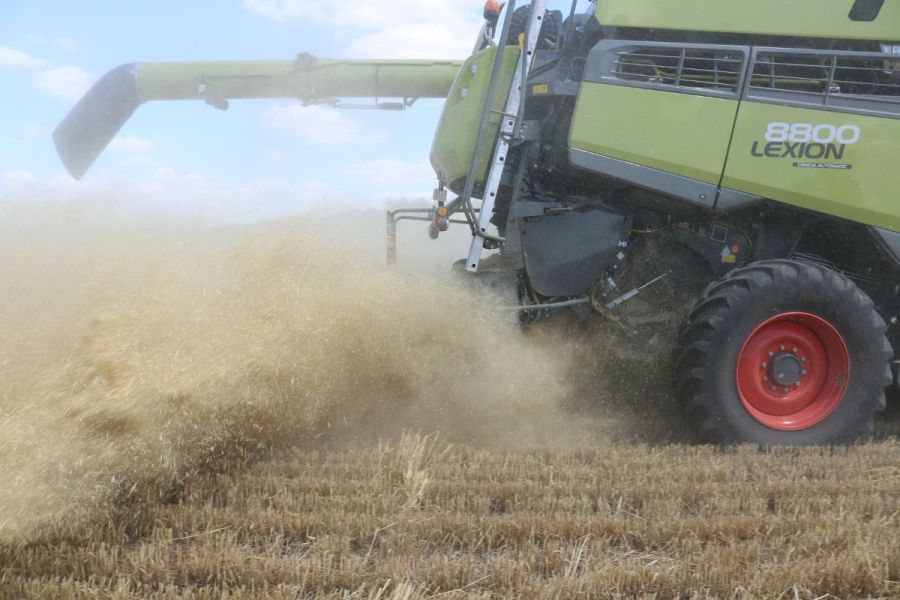Results from the second year of trials using a novel technology to control weeds at harvest has proven to reduce grassweed levels by up to 70%. CPM finds out more.
“It’s a completely different paradigm for weed control.”
By Charlotte Cunningham
Following success in 2022, a farmer-led project has once again proven the value of controlling yield-robbing weeds at harvest.
The Harvest Weed Seed Control (HWSC) project, led by the British On Farm Innovation Network (BOFIN) in collaboration with NIAB, is based around the Redekop Seed Control Unit (SCU) which can be retrofitted to combines and is claimed to destroy 98% of the weed seed that passes through.
BOFIN founder and Oxfordshire farmer, Tom Allen-Stevens, talked through the latest results in a recent webinar. “We’ve been looking at harvest weed control in three specific weeds – meadow brome, Italian ryegrass and blackgrass. We know that 98% of the seed that passes through the SCU is controlled – but what we don’t know is how much seed is going in at the front of the combine.”
Tom says that’s all down to how much seed shed there is before harvest, and so the second year of research has specifically looked to capture data on this, as well as continuing to explore the level of weed control that’s possible on commercial farms.
To recap on the first year of research, headline results included 54% retention of blackgrass seed at Adam Driver’s farm in Sussex, as well as 60% reduction in Italian ryegrass in winter barley and 44% reduction in spring barley at Ted Holmes’ farm in Warwickshire. Results were inconclusive at Jake Freestone’s Worcestershire farm.
The second year of research has included the original three farmers and the combine at NIAB’s Hinxton site but has been strengthened by bringing in Lincolnshire farm manager Keith Challen who’s fitted the SCU to his Fendt Ideal 10.
Building on work that Will Smith carried out in the previous year, John Cussans has headed up NIAB’s analysis for the most recent year of trials. He says the potential to fit the SCU to a wide range of combines is clear and the key observation was of a positive, trouble-free user experience.
This positive experience is despite farmers reporting increased fuel usage and engine load when the seed mill was engaged – something which was measured directly on the combine at the NIAB site. “We came up with a figure which was very reproducible and by using the telemetry from our combine we calculated the average increased fuel usage to be around 10%,” explains John.
While he says that this is something which should be taken into account, John believes this isn’t a significant enough figure to ’colour your opinion‘ on the value of the technology as a whole and will vary depending on the individual combine.
Turning focus to the research itself, John explains the work has not been focused on proving the efficacy of the SCU, but has instead looked at the level of control that’s possible within the harvest window. “We work on the safe assumption that the seed mill itself is incredibly effective. Almost all weed seeds that go into the mill – we’re talking more than 90% – are destroyed.
“We’re not repeating work that’s already been done in terms of the efficacy of the machine and there’s no reason to think UK weed seeds are any different to Australia or America, where the technology has already been proven.
“Essentially, what we’ve done is go onto farms where the SCU was fitted to commercial combines and set up some static tramline strips where the seed mill was engaged and disengaged. This enabled repeatability and replication on a large field scale.”
The research team carried out assessments on density of weeds/m2 prior to the SCU being used in the fields in the summer of 2022 to provide a baseline figure, followed by further assessment post-harvest in 2022 and 2023, explains John. “The results showed an immediate improvement when the SCU was engaged, which resulted in statistically significant differences in weed seedling levels in the following crop.”
That said, John says it’s important to put this into context with the fact that even if the SCU enabled 100% control of seedlings, growers would still have some weed seedlings in the following crop due to seed-bank populations. “The proportion of seedlings in a crop from freshly shed seed compared with a long-term seed-bank really depends on the system – how much mixing of the soil is done by cultivations, rotational sequence etc.
“As the balance of fresh seeds compared with those in the seed-banks changed, we saw two things. Firstly, that where weed populations were high in a crop, a higher effectiveness of the seed mill was observed.
“Secondly, on fields where there was much less cultivation – and therefore less mixing of the seed-bank to bring up older seeds – again, this resulted better effectiveness of the SCU.”
In terms of the figures and what this means practically on farm, John explains that seed mill effectiveness was estimated by averaging across all fields and all years where the weed species was observed at sufficient density. “This direct evaluation of effectiveness resulted in estimated reductions in weed seedling density of an average of 5% for blackgrass, 40% for Italian ryegrass and up 70% for brome – which included a mixture of meadow and sterile species.
“These values are performance over the whole system as measured by reduction in following crops – not seed mill efficacy – and are minimum values because they don’t account for the seed-bank reservoir.”
While further work and incorporating botanical expertise is likely to be required to better understand seed retention and maturity at harvest, John stresses that the results to date highlight the importance of controlling weeds at harvest, alongside existing practices. “This isn’t a pseudo-herbicide. Harvest weed seed control – with a seed mill in this case – means capturing seeds which have survived a previous attempt to be controlled. It’s a completely different paradigm for weed control.
“If we take another cultural control like delaying drilling for a month, figures show an average of a 40% reduction in blackgrass or Italian ryegrass seed heads. So with the seed mill, we’re talking about an equivalent level of control to a practice which has been the mainstay for weed control.
“This in theory means that growers who are already delaying drilling could potentially bolster control by adding an SCU in. But it also opens up the door to growers to challenge how they approach growing crops as a result of weed seed pressure.
“It could be the case in the future that they could change this – which in turn may benefit establishment or yield, for example – by incorporating a harvest weed seed control mechanism instead. As it stands, this technology could contribute significantly to making sustainable grassweed management a reality.”
This article was taken from the latest issue of CPM. Read the article in full here.
For more articles like this, subscribe here.
Sign up for Crop Production Magazine’s FREE e-newsletter here.




